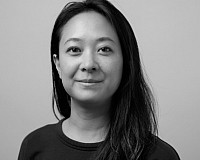How to create a portfolio for employment interviews
Think of your life and your complete archive of work as a “movie.” Your portfolio is the movie trailer ~ short and tailored to the interests of an employer.
A portfolio appropriate for employment interviews will be much shorter than a portfolio that is an archive of all of your work. Curate your work!
Your portfolio is not about the projects. The portfolio is about YOUR SKILLS and YOUR PROCESS. The firm is considering your potential contribution to the team, your skills, communication style, and how you think.
Curate your entire inventory of work and choose 5 academic projects max.
Of the 5 projects, one project (comprehensive design, for example) may require up to 4 spreads to showcase your skills. Be sure to credit collaborator(s).
For the other 4 projects, plan to use one or two 2-page spread(s) per project with each page of the spread featuring 3-5 images; a 2-page spread will have 6-10 images max.
Design your portfolio with a Project List and Title Pages to “air out” the layout; brief descriptions of the project problem and solution are acceptable, but not required. Text is “image,” so consider creating a strong grid for all text to be located on the same part of each page consistently. Use “clockwise from top left” instead of numbers or letters cluttering the page.
If you choose to add a description of the problem and your solution, be sure to proof the text using a spellchecker.
Page numbers are not necessary and may only clutter your page.
Content
- Omit semester & year notations, course #.
- Include process work: sketches, trace, diagrams, study models, screen shots
- Include hand sketches and personal artwork if that is a strength
Layout
Add a Project List as first page.
Most employers prefer to see your “favorite” project first because they want to see what energizes you.
Refrain from using a chronological order for projects.
Limit Florence, London drawings to one or two 2-page spread(s).
Limit personal artwork/photography to one or 2-page spread(s).
Limit professional drawings to one or two 2-page spread(s).
Consider using title pages for each project so that all text will be in one place.
No need to label drawing types: plan, elevation, section, rendering. Instead, name the software or other media: V-Ray, AutoCAD with Photoshop, Cinema4D, 3DViz, 3ds Max, watercolor, gouache, clay, concrete.
Make sure that order of projects “tells a story” about you & your skills. Rehearse the “flow” of your presentation. Put the site plan first.
Balance images & captions with white space. More white space is better than not enough.
Need graphic consistency for text; all text placed consistently in same location on each page, or placed with design intent.
Don’t place landscape and portrait as facing pages.
Minimum size portfolio is 10x10 or 8x11.
Gutter must be large enough for binding.
Last page = blank white page or personal sketch, photo.
Text
The only text required on the project pages is 1)name of project, 2) site, 3)name of professor, 4)name of collaborator(s).
Do not use “I” or “my” or other pronouns in text.
Do not mix font styles in your text.
Copy all text into MS Word and run Spellchecker .
Group Project? Credit all collaborators.
Work done at a firm? Credit professional work to firm.
Front and back Covers
Do not use the “free” acetate cover offered by printer.
Paper for cover should be at least 80#; 120# is best.
The only text required on front cover is your name; no need to include name of school or contact information.
Covers may image(s), but it is not necessary and can be risky.
Back cover may be blank or include your name and contact information.
Material
Paper for interior pages: Minimum weight = 60#; 80# is common.
Use “Wire-O” binding instead of spiral or “perfect” binding.
Refrain from using plastic pocket sleeves or high gloss paper.
Portfolio must lay flat for viewing. Do not use “perfect” binding.
Employer Requirements for your portfolio
These tips are based on employer comments about student portfolios.
1. Do not arrange it in chronological order. Instead, create an order of projects that communicates your highest level of skill. Put the best image you have ever created in your whole life on the 1st page. Put the second best image as your last page. You might only feature three projects, depending on how many studios you have had; it is OK to present as many as seven if you are a thesis student. Architects like to see at least one project presented in full, from process through final drawings.
2. The number of pages does not matter as much as the quality of the images and diversity of skills demonstrated. Only use model photos that are well composed, including lighting, background, and perspective. Bad photo of good model = negative.
3. Show process! Be sure to save and reproduce your “trace”; they like to see “early thinking.”
Save and photograph or bring study models to the interview if you don’t have any early drawings.
4. Arrange the images so that the orientation is 100% vertical OR 100% horizontal or requires no more than 2 twists of the binder to get through it.
5. Be careful that images are not reduced so small that the interviewer cannot see “the information” in the image. Too many tiny images make the page illegible.
6. Don’t spend too much time on text for an employment portfolio. Employers won’t take the time to read it. A grad school portfolio needs text, but limited captions are sufficient for hiring. Recommended text is the name of the project & a description of the media used to create the image. If image or design is produced in collaboration, credit all collaborators by name. If produced during employment for a firm, credit firm. Always include the name of your professor(s), but omit course number and dates.
7. Be sure to include professional work completed in your summer jobs. Ask your employer for permission to add them to your portfolio. Even though the images usually represent “team” work, or the design is less than “cutting edge”, these drawings are valuable for your portfolio.
8. Less is more. If you are not sure you want to include an image, don’t!
9. Binding: Employers prefer the “Wire-O” style of binding. Spiral binding is ok, but your pages will not align flush because of the spiral. If you decide to fabricate your own portfolio cover, make sure it will open and lie flat … and make sure the craft is excellent. “Perfect Binding” is NOT recommended because the pages will not lay flat.
10. Title Pages: Consider using title pages for each project as breaks in the portfolio. Title pages may feature the name of the project, site, program, or concept. You may also include a diagram or icon image.
11. Size: Minimum size is 10x10 or 8x11. If you create a smaller portfolio, you must print multiple copies for interviews with 2 or more interviewers.
12. Number of Pages: Thesis student portfolios should include three to seven projects (five is typical); number of pages is dependent on layout. Generally, one or two “2-page spreads” per project is sufficient.
13. Spellcheck
Portfolio Number of Pages
The number of pages in a thesis student’s portfolio is less of an issue as the amount of “ink.” In other words, the number of images can be overwhelming to an employer/reviewer who can only afford to give you 15-20 mins of time. The number of projects expected is 5 academic projects. You might also have 1-2 spreads of travel sketches from Florence/Study Abroad. You might also have 1-2 spreads of images from your professional summer jobs. And you might also have 1-2 spreads of personal artwork or photography. Adding that up, assuming that comp design is 3 spreads and your other academic projects are 2 spreads each:
3 spreads comp design
2 for project 2
2 for project 3
1 spread for project 4
1 spread for project 5
1 spread sketches (or other hand art)
1 spread professional dwgs from summer or freelance jobs
1 spread of personal artwork, furniture, sculpture, jewelry, ceramics
12 spreads total plus Project List.
Depending on your layout and graphic style, you may also have “title page.”
A collage style is difficult for the entire portfolio but, if collage is one of your strengths, it is acceptable to use it for images one or two spreads.
Don’t be concerned with the number of pages. Instead, think about number of projects (5max). If your style is to put one image per page you will need more pieces of paper, even though you are staying under the suggested 5 projects.
Your portfolio is not going to be a complete inventory of everything you have done. The employer (and other readers) expect you to critique your own work and pull out the images that BEST describe your BEST skills and your DEEPEST interest. Succint is always appreciated in the business world.
However, for your own archives, it is wonderful to have the complete collection organized by dates or some other theme. But that version may never actually be seen by anyone other than yourself and close friends/family.
The portfolio on http://www.issuu.com should be the same that you would use in an interview your work, edited. If you want to have a complete archive available online, that might be better done in a website that can be managed with links, rather than worrying about file size as one needs to do with ISSUU.
The Pros & Cons of a digital portfolio
Pro:
Employer can review prior to or after interview
Some images may look more crisp on the screen
Animations can be shown
Possible for the reader to control the laptop or tablet
Con:
Technical problems (battery, connection)
Difficult for multiple people to review simultaneously
Glare problems
Lengthy setup time
Talking to the screen instead of audience
EMAIL or ONLINE PORTFOLIO
If you email attach your resume and sample images, the PDF must be 5 MB or less total file size.
If you load your portfolio to a personal website or use an online template like http://www.issuu.com, the employer can learn more about your talent and the concern about file size disappears.
If the firm ASKS for a PDF, it is better to accommodate that request and also offer your online portfolio link in your cover letter.
If you have an online portfolio or website, add that link to your http://www.linkedin.com profile.
If a firm does not specify their submission requirements for your first contact, you can offer a crisp cover letter, resume and sample pages in a PDF 5MB or less file size.
They care more about YOU than they care about your projects!
Portfolios are expensive to print & bind, and firms are then left with the problem of storage, returning it, or tossing it. Usually a link or 3MB of image pages is enough to start the process.
Create a spreadsheet with names of contacts, dates of interactions and dates for follow-up. Also track what you have already sent to your contacts.
Requesting copies of images produced for an employer:
1. Anything you produced in a professional setting is valuable. Ask for permission to get copies of your work for your portfolio. It is a good idea to ask your supervisor “what do you think would be the most valuable and appropriate for my portfolio?” so that you can hear her/his opinion.
2. Ask permission: You may be unaware of a contract issue regarding confidentiality.
3. When you design your portfolio, you make have one two-page spread of your professional work, and up to 3 spreads. The space limitation will help you know what images to use, choosing from the inventory you have.
4. All of your work, whether you did it solo or as part of a team will be credited to the firm.
For example:
“CD details produced using AutoCAD for Walson Architects.”
Or
“Revit drawing produced in collaboration with design team for Walson, Architects.”
Or
“Rendering produced using Rhino in collaboration with project team, for Walson Architects.”
You can never credit too much or too thoroughly.
5. Generally, the images you choose to use in your portfolio will be the ones which demonstrate your most advanced skills. But don’t hesitate to show early schematic work and process.
6. Don’t worry about the actual design or project type. The interviewer is looking at YOUR skills, not your firm’s design work.











